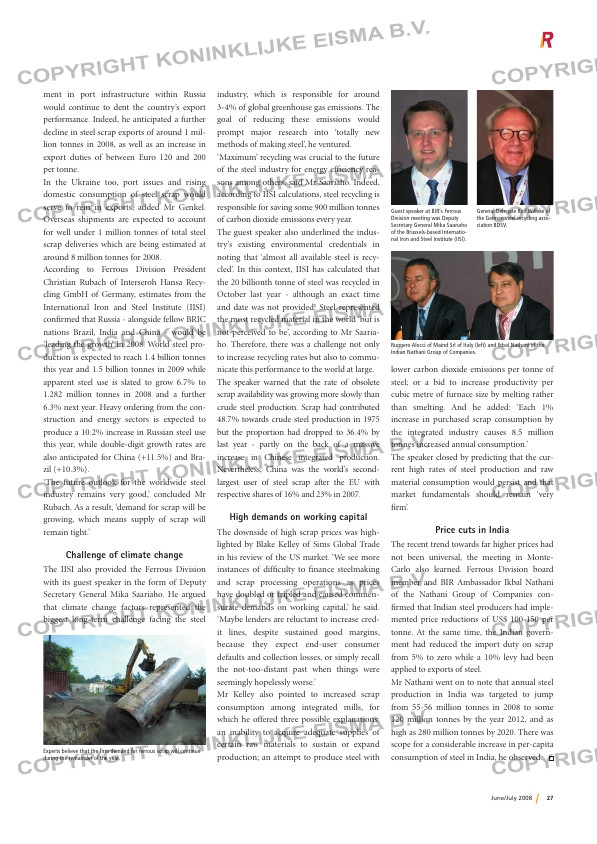Page 27 from: June / July 2008

27
lower carbon dioxide emissions per tonne of
steel; or a bid to increase productivity per
cubic metre of furnace size by melting rather
than smelting. And he added: ‘Each 1%
increase in purchased scrap consumption by
the integrated industry causes 8.5 million
tonnes increased annual consumption.’
The speaker closed by predicting that the cur-
rent high rates of steel production and raw
material consumption would persist and that
market fundamentals should remain ‘very
firm’.
Price cuts in India
The recent trend towards far higher prices had
not been universal, the meeting in Monte-
Carlo also learned. Ferrous Division board
member and BIR Ambassador Ikbal Nathani
of the Nathani Group of Companies con-
firmed that Indian steel producers had imple-
mented price reductions of US$ 100-150 per
tonne. At the same time, the Indian govern-
ment had reduced the import duty on scrap
from 5% to zero while a 10% levy had been
applied to exports of steel.
Mr Nathani went on to note that annual steel
production in India was targeted to jump
from 55-56 million tonnes in 2008 to some
120 million tonnes by the year 2012, and as
high as 280 million tonnes by 2020. There was
scope for a considerable increase in per-capita
consumption of steel in India, he observed.
June/July 2008
ment in port infrastructure within Russia
would continue to dent the country’s export
performance. Indeed, he anticipated a further
decline in steel scrap exports of around 1 mil-
lion tonnes in 2008, as well as an increase in
export duties of between Euro 120 and 200
per tonne.
In the Ukraine too, port issues and rising
domestic consumption of steel scrap would
serve to rein in exports, added Mr Genkel.
Overseas shipments are expected to account
for well under 1 million tonnes of total steel
scrap deliveries which are being estimated at
around 8 million tonnes for 2008.
According to Ferrous Division President
Christian Rubach of Interseroh Hansa Recy-
cling GmbH of Germany, estimates from the
International Iron and Steel Institute (IISI)
confirmed that Russia – alongside fellow BRIC
nations Brazil, India and China – would be
‘leading the growth’ in 2008. World steel pro-
duction is expected to reach 1.4 billion tonnes
this year and 1.5 billion tonnes in 2009 while
apparent steel use is slated to grow 6.7% to
1.282 million tonnes in 2008 and a further
6.3% next year. Heavy ordering from the con-
struction and energy sectors is expected to
produce a 10.2% increase in Russian steel use
this year, while double-digit growth rates are
also anticipated for China (+11.5%) and Bra-
zil (+10.3%).
‘The future outlook for the worldwide steel
industry remains very good,’ concluded Mr
Rubach. As a result, ‘demand for scrap will be
growing, which means supply of scrap will
remain tight.’
Challenge of climate change
The IISI also provided the Ferrous Division
with its guest speaker in the form of Deputy
Secretary General Mika Saariaho. He argued
that climate change factors represented the
biggest long-term challenge facing the steel
industry, which is responsible for around
3-4% of global greenhouse gas emissions. The
goal of reducing these emissions would
prompt major research into ‘totally new
methods of making steel’, he ventured.
‘Maximum’ recycling was crucial to the future
of the steel industry for energy efficiency rea-
sons among others, said Mr Saariaho. Indeed,
according to IISI calculations, steel recycling is
responsible for saving some 900 million tonnes
of carbon dioxide emissions every year.
The guest speaker also underlined the indus-
try’s existing environmental credentials in
noting that ‘almost all available steel is recy-
cled’. In this context, IISI has calculated that
the 20 billionth tonne of steel was recycled in
October last year – although an exact time
and date was not provided! Steel represented
the most recycled material in the world ‘but is
not perceived to be’, according to Mr Saaria-
ho. Therefore, there was a challenge not only
to increase recycling rates but also to commu-
nicate this performance to the world at large.
The speaker warned that the rate of obsolete
scrap availability was growing more slowly than
crude steel production. Scrap had contributed
48.7% towards crude steel production in 1975
but the proportion had dropped to 36.4% by
last year – partly on the back of a massive
increase in Chinese integrated production.
Nevertheless, China was the world’s second-
largest user of steel scrap after the EU with
respective shares of 16% and 23% in 2007.
High demands on working capital
The downside of high scrap prices was high-
lighted by Blake Kelley of Sims Global Trade
in his review of the US market. ‘We see more
instances of difficulty to finance steelmaking
and scrap processing operations as prices
have doubled or tripled and caused commen-
surate demands on working capital,’ he said.
‘Maybe lenders are reluctant to increase cred-
it lines, despite sustained good margins,
because they expect end-user consumer
defaults and collection losses, or simply recall
the not-too-distant past when things were
seemingly hopelessly worse.’
Mr Kelley also pointed to increased scrap
consumption among integrated mills, for
which he offered three possible explanations:
an inability to acquire adequate supplies of
certain raw materials to sustain or expand
production; an attempt to produce steel with
Experts believe that the firm demand for ferrous scrap will continue
during the remainder of the year.
Ruggero Alocci of Maind Srl of Italy (left) and Ikbal Nathani of the
Indian Nathani Group of Companies.
Guest speaker at BIR’s Ferrous
Division meeting was Deputy
Secretary General Mika Saariaho
of the Brussels-based Internatio-
nal Iron and Steel Institute (IISI).
General Delegate Rolf Willeke of
the German steel recycling asso-
ciation BDSV.
RI_010 BIR Ferrous.indd 27 19-06-2008 14:53:20



